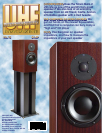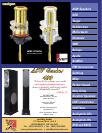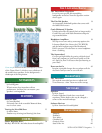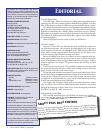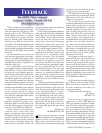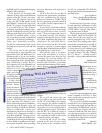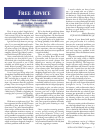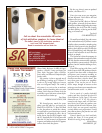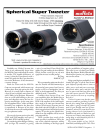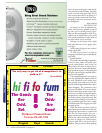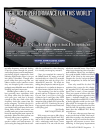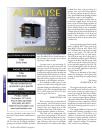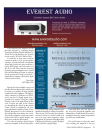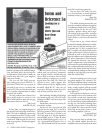
First, let me say that I bought both of
your books on high fidelity and loved them.
I also received a copy of your magazine and
have subscribed for the next two years. I also
ordered six of the most current back issues.
I got back into hi-fi about two years ago
after 15 or so years and find myself wonder-
ing why I ever got out. My current two chan-
nel system consists of the following: Wadia
861 standard CD player, CAT JL-2 tube
amplifier, Martin Logan Odyssey speakers,
and Audio Research PH3 phono preamp.
I have a small collection of vinyl record-
ings that have not been played in years. I
have had the itch to incorporate analog into
my system. My question to you is which
turntable you would suggest to match the
Audio Research preamp? I don’t want to
spend much more than $3500 in total for
the turntable and cartridge.
I have heard good things about both
Nottingham’s Spacedeck and turntables from
Pro-Ject. I purchased the Audio Research
PH3 used and plan to upgrade in a year
or so to the CAT SL1 preamp with phono
input. Any comments about this particular
preamp? I have been using an old Thorens
turntable that I had lying around, but I have
not been very happy with its performance.
I didn’t know if I should try upgrading the
cartridge first or just move on right away.
Carl Waldbillig
WEST CHESTER, OH
We’d move on right away, Carl. The
best argument in favor of used Thorens
turntables is that people all but give
them away. They were somewhat better
than average, and better than the Duals,
whose reputation remains a mystery to
us, but their tone arms were wretched,
and we wouldn’t overspend on a cartridge
for a Thorens arm. Incidentally, they are
unrelated to the modern Thorens tables,
which seem better designed, though we
still have problems with the arms.
We’ve also heard good things about
the Nottingham, with which we have
however no experience. We have listened
to several Pro-Ject turntables, and there
may be a good choice to be made from
its lineup, probably in the RPM series.
Note that Pro-Ject offers electronic
speed control as an extra-cost accessory.
In our experience, that sort of upgrade
affects more than just correct speed and
is worth including.
There are several cartridge brands
we like, including Benz Micro and
Clearaudio, and we hear the newest
Dynavectors are worth a detour. You
should get a moving coil pickup, or
failing that a moving magnet cartridge
with very low inductance, and certainly
a line contact stylus. Your budget won’t
let you buy the very top, but careful
shopping should score you a very good
experience. There are of course other
possible brands of turntables, including
Rega and Clearaudio, to name but two.
You may want to choose a model that
is available with local service, because a
top turntable that isn’t aligned properly
is not going to give you what you pay
for. And little things are going to count,
because you have a high resolution
system. We can presume that adding the
SL1 preamplifier will let you hear with
even greater clarity anything that may be
wrong with the source. On the positive
side, your system’s resolution will make
you very glad you’re listening to vinyl
again.
I have a question concerning acoustics,
or more precisely treating my listening
room for low frequencies. I have a very
good sound system that reproduces highs and
the midrange marvellously well. The low
frequencies have good impact, but there’s a
sort of boominess around 80 to 100 Hz (hard
to be sure), suggesting a resonance.
I wonder whether you know of some
way — for example some sort of panel —
that could reduce this phenomenon, or better
yet eliminate it. I have already built panels
two inches thick of different shapes, using a
Masonite sheet on which I had glued with
liquid tar a very heavy black paper, all nailed
into a frame made from two-inch wood. I
had screwed the panels to the ceiling in my
former home in Repentigny and the results
had been very good. But now I live in the
Gaspé. What do you think?
Marien Desrosiers
ST-JEAN DE CHERBOURG, QC
Marien, if your home-built panels
gave you good results it is certainly
because the acoustical problems you
then had were in a different part of the
frequency band. From what you say
your new room has a problem in the
extreme lows. Here the solution is more
complicated.
Why more complicated? It’s because
sounds in the range of 80 to 100 Hz
have a very long wavelength (more than
3 metres for 100 Hz!). The long wave-
length will pass easily through a thin
panel and bounce off whatever is on the
other side. A panel that can deal with
such frequencies needs to be…thicker.
In the case of our Alpha room, the home
of our original reference system, behind
one wall is a bass trap nearly a metre
deep! A radical solution to be sure.
It’s possible to build a freestanding
bass trap with well-chosen dimensions
(it might be 1 m by 75 cm by 60 cm,
for instance, with no dimension that is
a multiple of another dimension), built
from materials that are relatively non-
resonant put permeable to sound. You
would fill it with mineral wool, so that
air vibrating within the cavity would
rub against the fibres and be dissipated
as heat.
However certain articles of furniture
can also help absorb bass, at least to a
point. A well upholstered sofa can help,
as can a bookcase full of books. Finally,
changes in speaker placements can have
a great influence on what you hear. Since
moving speakers is free, that is where we
would start.
My equipment consists of a Roksan
Radius 5 turntable, a Rega Fono, a Rega
Box 65085, Place Longueuil
Longueuil, Québec, Canada J4K 5J4
uhfmail@uhfmag.com
Free Advice
ULTRA HIGH FIDELITY Magazine 7



